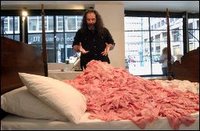
In 2004, Cosimo Cavallaro spread 315 lbs of sliced deli ham on a four poster bed. He called this art. I call this dumb.
Many people join with me in questioning the artfulness of Cavallaro’s work. What then is art? Fred Ross, chairman of the Art Renewal Center, wrote the essay, “Bad Art/Good Art,” saying, “Well, if everything is art, then nothing is art. Any definition that includes everything is not a definition at all.”
I propose a more exclusive definition of art: the skillful, conscious production of aesthetic material which beautifies and explains life.
According to Dictionary.com, artistry requires skill: a superior skill that you can learn by study and practice and observation. Much modern artwork, such as Cavallaro’s “ham bed” or Chris Ofili’s “The Virgin Mary” (made of several materials including elephant dung), doesn’t demonstrate skill. Ross describes the modern art philosophy, “Whether you dribble little dollops of colors or drag fat uneven slashes of black...The effect is always the same. MEANINGLESS PRIMITIVISM.” The ability to accurately and vividly portray a landscape now pales in the face of defecatory material smeared over a poorly depicted representation of the Virgin Mary. True art should be valued for the artist’s mastery of the medium.
Good art is beautiful. People buy sculptures, hang photos, and admire paintings because they are lovely. The Artist of this world, God, created a planet so vibrant and visually pleasing that humans endlessly enjoy trying to capture their own representation of it. Whether delighting in a bright yellow daffodil, the way the sun hits the edge of a cloud, or the black-purple colors during a thunderstorm, we appreciate the aesthetic value of the earth. Vincent Van Gogh’s “Starry Night” depicts a night sky glowing with stars. Although anyone might observe a starry night, Van Gogh drew attention to potentially unnoticed beauty. Georgia O’Keeffe painted flowers close up, giving care to tiny details like the black centers of two poppies.
Finally, some art doesn’t qualify as beautiful, but can be valued because it seeks to explain life. My art professor believes that good art provides answers. There is value in compositions which portray suffering, because they explain the realities of life. Jean-Léon Gérôme’s painting “Pollice Verso” portrays a crowd giving the thumbs down in a gladiator fight. Can you say that this painting is beautiful? Not really, but one can see the work as an explanation of Roman life at the time.
Given the subjective nature of art, its quality will always be debated. However, if artists demonstrate skill in their work and the art beautifies or explains life, there’s a good possibility that the art has value. Just don’t expect me to be impressed if you call a bloody, crumpled up piece of Kleenex art.
Tuesday, May 23, 2006
Defining Art
Posted by
the traveler
at
9:41 PM
![]()
Subscribe to:
Post Comments (Atom)

2 comments:
Excellent post!
I'm appalled at what our modern society calls "art". I know a few artists in my town, and they paint beautiful landscapes, portraits (of animals and people), and many other things that take skill, not just an active imagination for what the general public doesn't want to see anyway.
Why anyone would waste hundreds of pounds of good food is beyond me.
Thank you for posting this.
Zac
There is one story that comes to mind whenever I hear about the crazy "art" that is now on display. There was once a janitor who accidentally disposed of a “masterpiece” at a museum. It looked like a bag of trash!
Very good post!
Post a Comment